WW1 Memorial in Y Tabernacl, the Welsh Baptist chapel in Cardiff
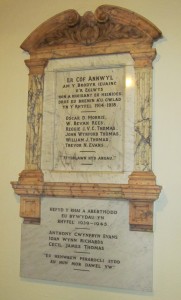 On a wall inside the Tabernacl, the Welsh Baptist chapel on the Hayes in central Cardiff, there is a memorial to the six men of the congregation who died in the Great War.
On a wall inside the Tabernacl, the Welsh Baptist chapel on the Hayes in central Cardiff, there is a memorial to the six men of the congregation who died in the Great War.
The memorial itself is impressive, being carved in marble.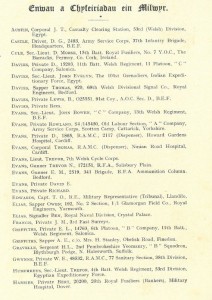
There are no records to indicate whether the chapel displayed a ‘Roll of Honour’ as the war was being fought, to highlight the contribution of a large number of the congregation to the war effort. However, the chapel’s Annual Reports do note the names of all the men who enlisted, and so we can trace how the war had a deeper effect every year on the congregation. There were 45 names on the list at the end of 1915, 62 by the end of 1916 and 66 in 1917 (including four who had been killed). The membership of the Tabernacl during the war fluctuated from around 520 to 560, so the total of 66 represents a sizeable proportion of the young male membership of the church.
List of chapel members serving in 1916
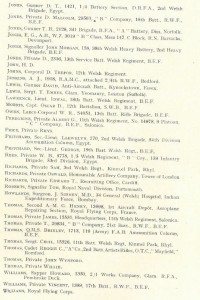
We can also see how the War’s impact became deeper and more painful from the minister’s comments in the reports. At the end of 1914 there was more discussion about the fire that had damaged the chapel than about the War, but the Rev Charles Davies’ comments became ever more emotional as the war dragged on and took an ever-increasing number of young men from his flock. Looking back upon 1916, he wrote that the young men left a large gap, and that their valuable contribution to the life of the chapel was deeply missed by those who were left. However, there is no doubt that the minister considered the war to be just, as he used such words as ‘teyrngarwch’ (loyalty), ‘dewrder’ (courage) and ‘aberth’ (sacrifice) to describe the men’s contribution to the war effort. He declared that as they faced the dangers and discomforts of the war, they were fighting ‘er amddiffyn ein gwlad, a sicrhau buddugoliaeth i gyfiawnder a gwir rhyddid yn ein byd’ (to defend our country, and to ensure a victory for justice and for the true freedom of our world).
In the lists of the men there is information about where a number of them were serving. At the end of 1916 a large number were in training camps in England or Wales; 14 with the BEF (British Expeditionary Force) on the Western Front; six in Egypt; four in Salonica and one in Bombay.
The first name on the memorial is Oscar D. Morris. It is possible to find a great deal of information about him: the letter he wrote as he sought to join the Welsh Army Corps are available on the Cymru1914 website – http://cymru1914.org/en/view/archive/4089505
One can also find a report on his promotion to lieutenant (August 1915 – http://cymru1914.org/en/view/newspaper/3886208/7/ART121) and then reports on his death on the Western Front on 21 April 1917 (http://cymru1914.org/en/view/newspaper/3886989/1/ART11 and http://cymru1914.org/en/view/newspaper/3886999/3/ART35 ). 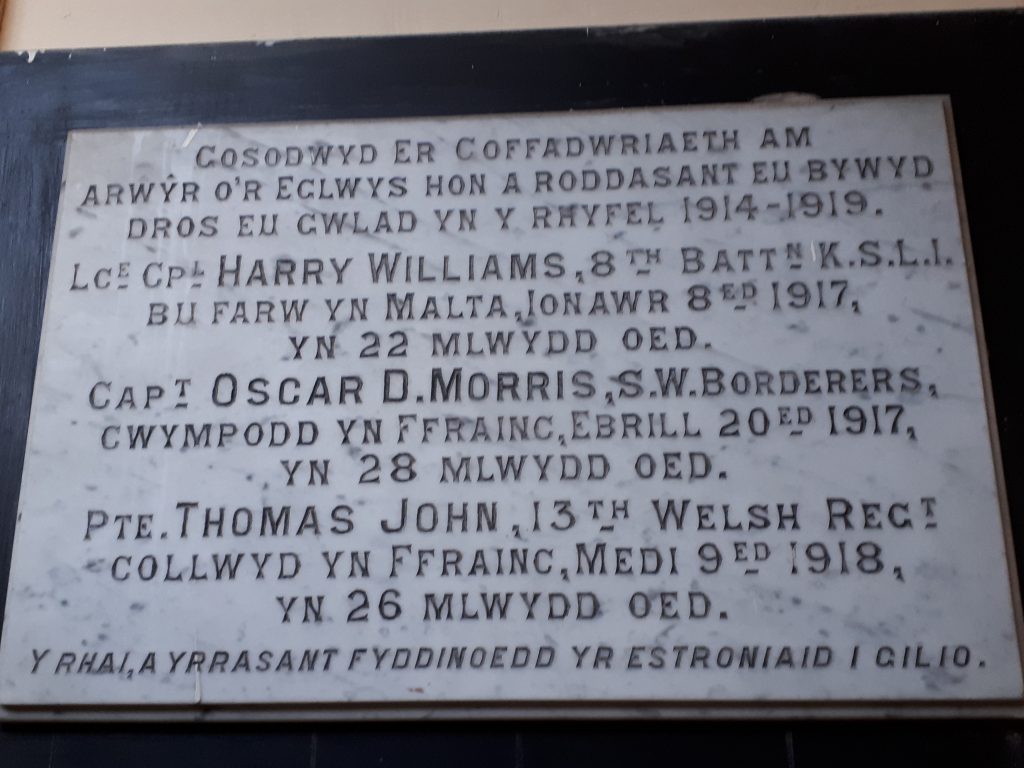
Oscar’s name is also to be found on the memorial in his home chapel – Salem Nantyffyllon.
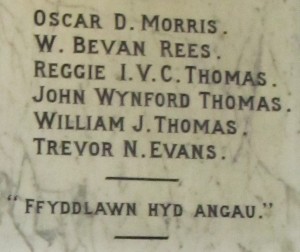 The second name is W. Bevan Rees, originally from Llandybïe, Carmarthenshire (who was 20 years old and working as a miner at the time of the 1911 census). He died in Palestine on 3 November 1917.
The second name is W. Bevan Rees, originally from Llandybïe, Carmarthenshire (who was 20 years old and working as a miner at the time of the 1911 census). He died in Palestine on 3 November 1917.
Reggie I.V.C.Thomas is the next name: he died on 24 November 1917 aged 19, while serving on the Western Front with the South Wales Borderers. He has no known grave, but his name is on the Cambrai memorial.
One can find John Wynford Thomas as a 12 year old boy in the 1911 Census, living in Lampeter Velfrey. There is no indication of when he moved to Cardiff, but he enlisted in the city, joining the South Wales Borderers. He was killed in Flanders on 31 October 1917.
Despite his common name, it is certain that the William John Thomas named on the memorial was an 18 year old who died on 11 July 1918 while serving with the Army Service Corps. He is buried in Cathays Cemetery, Cardiff.
However, the final name on the memorial is not on the list of the Commonwealth War Graves Commission. According to the Tabernacl’s records he was a soldier in 1916, serving as a Gunner with the RFA (Royal Field Artillery) on Salisbury Plain. The chapel’s report says that he died on 18 February 1919.
g.h.matthews March 22nd, 2016
Posted In: chapels / capeli, memorials, Uncategorized
Tags: chapels / capeli, memorials, WW1
Diolch am yr erthygl hyfryd. Mae’r cofio yn bwysig bob adeg.
I have the records of the manufacture of this tablet if anyone is interested. It features in the article you will find at
https://museum.wales/curadurol/daeareg/fforwm-cerrig-cymru/projects/
It is only partly made of marble, the pink members are Penarth alabaster.
The memorial is located near the site of the engagement in northern France. It can be reached from the village of Mametz on the D64 road.
Dear Dr. Matthews,
I had the pleasure of hearing your lecture at Aberdare recently. Can you please let me know which chapel (Tabernacle perhaps?) had the Goscombe John figure of Minerva/Britannia.
sincerely,
Geoff Evans
Hello. Thanks.Excellent article.